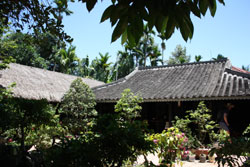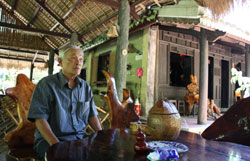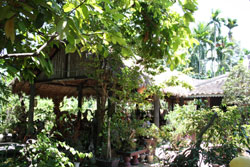The
coastal city of Nha Trang is located in Khanh Hoa Province in the
south-central region of Vietnam, 440km north-east of HCM City. Known for
the friendliness of its people, the city is flanked by nearly 10km of
white-sand coastline, where the clear waters are warm all year round.
But don't be fooled into thinking Nha Trang is just a beautiful
beach-side location – there's so much more. You can check out the city's
ancient houses, a fascinating example of the cultural heritage that is
being preserved by local people.
According to the provincial Department
of Culture, Sports and Tourism, Khanh Hoa has around 50 old houses,
mostly located in the districts of Dien Khanh and Ninh Hoa, and Nha
Trang City. One-third of the houses are more than 100 years.
About 4km from the city centre, Phu Vinh Village in Vinh Thanh Commune, is well-known in the area for its old houses, many of which bear unique characteristics. The city's culture sector has singled out six houses that are almost intact, including old-style interior decor as well as vintage household objects.
Visiting these houses will give you an insight into old customs, worship practices and the way local people lived many years ago.
There are two different ways to Phu Vinh Village: by car or by boat. Under the August scorching sun, I decided to take a boat along the Cai River, which starts 900m above sea level in the Central Highlands province of Dak Lak and runs through Nha Trang.
It turned out to be a smart choice. As I was heading up river to the village, I felt completely relaxed. Along the way you can see some quintessentially Vietnamese landscapes of palm trees on the river banks and makeshift bamboo bridges crossing the river.
About 30 minutes from the pier at the foot of the Po Nagar Temples complex, the boat stops at a small pier on the property of 72-year-old Nguyen Xuan Hai. His property in the village is open to visitors as an example of the area's traditional architecture. Surrounded by a garden, from the pier to the house you will stroll along a path filled with green trees blowing in the breeze.
This is one of the only six antique houses left in this village. The houses were all built according to a layout of three rooms in a structure supported by 36 pillars.
Hai's house has been extremely well preserved and he boasts that the house has never undergone major repairs during the six generations that have lived here.
Built 200 years ago, the house still has its original wooden doors, altars and pillars, which are carved with inscriptions. In accordance with tradition, altars for worshipping the family's ancestors take a central position in the house.
Like other houses in the village, Hai's faces the southeast and has a roof of yin and yang tiles. That's why Hai told me "you would feel like there is an air conditioner running inside the house even when it's hot outside".
The house is located in the middle of a massive garden covering more than 1,000sq.m and filled with fruit trees and indigenous plants. If you come at the right time, Hai may even treat you with some seasonal fruit in his garden.
The house's owner also spends his free time sculpting tables and chairs from tree roots from the area. He regularly entertains visitors to the house and garden, sipping green tea or a soft drink and enjoying the pleasant atmosphere.
It's easy to see why this part of south-central Vietnam attracts people from all over the world. From the laid back atmosphere of the magical islands and beaches to the old houses by the Cai River, all give you a sense of the diversity and beauty of Vietnam.
 |
| Leafy: Nguyen Xuan Hai's house has been singled out to serve sightseeing tours. |
 |
| Gnarly: Hai often entertains visitors with tables and chairs he sculpts from tree roots. |
 |
| Shady: The house sits in the middle of a massive garden, providing a complete cool atmosphere. |
About 4km from the city centre, Phu Vinh Village in Vinh Thanh Commune, is well-known in the area for its old houses, many of which bear unique characteristics. The city's culture sector has singled out six houses that are almost intact, including old-style interior decor as well as vintage household objects.
Visiting these houses will give you an insight into old customs, worship practices and the way local people lived many years ago.
There are two different ways to Phu Vinh Village: by car or by boat. Under the August scorching sun, I decided to take a boat along the Cai River, which starts 900m above sea level in the Central Highlands province of Dak Lak and runs through Nha Trang.
It turned out to be a smart choice. As I was heading up river to the village, I felt completely relaxed. Along the way you can see some quintessentially Vietnamese landscapes of palm trees on the river banks and makeshift bamboo bridges crossing the river.
About 30 minutes from the pier at the foot of the Po Nagar Temples complex, the boat stops at a small pier on the property of 72-year-old Nguyen Xuan Hai. His property in the village is open to visitors as an example of the area's traditional architecture. Surrounded by a garden, from the pier to the house you will stroll along a path filled with green trees blowing in the breeze.
This is one of the only six antique houses left in this village. The houses were all built according to a layout of three rooms in a structure supported by 36 pillars.
Hai's house has been extremely well preserved and he boasts that the house has never undergone major repairs during the six generations that have lived here.
Built 200 years ago, the house still has its original wooden doors, altars and pillars, which are carved with inscriptions. In accordance with tradition, altars for worshipping the family's ancestors take a central position in the house.
Like other houses in the village, Hai's faces the southeast and has a roof of yin and yang tiles. That's why Hai told me "you would feel like there is an air conditioner running inside the house even when it's hot outside".
The house is located in the middle of a massive garden covering more than 1,000sq.m and filled with fruit trees and indigenous plants. If you come at the right time, Hai may even treat you with some seasonal fruit in his garden.
The house's owner also spends his free time sculpting tables and chairs from tree roots from the area. He regularly entertains visitors to the house and garden, sipping green tea or a soft drink and enjoying the pleasant atmosphere.
It's easy to see why this part of south-central Vietnam attracts people from all over the world. From the laid back atmosphere of the magical islands and beaches to the old houses by the Cai River, all give you a sense of the diversity and beauty of Vietnam.
No comments:
Post a Comment